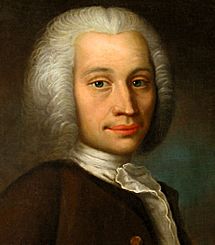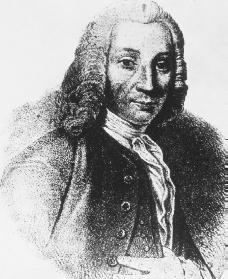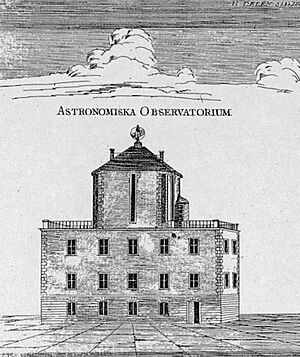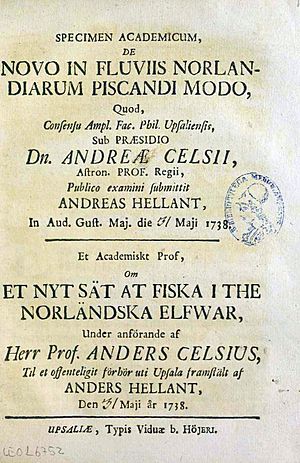Anders Celsius facts for kids
Quick facts for kids
Anders Celsius
|
|
|---|---|

Portrait by Olof Arenius
|
|
| Born | 27 November 1701 Uppsala, Sweden
|
| Died | 25 April 1744 (aged 42) Uppsala, Sweden
|
| Nationality | Swedish |
| Alma mater | Uppsala University |
| Known for | Celsius |
| Scientific career | |
| Fields | Astronomy, Physics, Mathematics, Geology |
| Signature | |
Anders Celsius (Swedish pronunciation: [ˈânːdɛʂ ˈsɛ̌lːsɪɵs]; born November 27, 1701 – died April 25, 1744) was a famous Swedish scientist. He was an astronomer, a physicist, and a mathematician. He taught astronomy at Uppsala University in Sweden from 1730 to 1744. Celsius traveled a lot between 1732 and 1735, visiting important observatories in Europe. In 1741, he started the Uppsala Astronomical Observatory. A year later, in 1742, he suggested a new temperature scale. This scale was later named Celsius in his honor.
Early Life and Learning
Anders Celsius was born in Uppsala, Sweden, on November 27, 1701. His family came from a place called Ovanåker. The name Celsius comes from a Latin word meaning "mound," which was the name of their family's land.
Science was in Anders Celsius's family. His father, Nils Celsius, was also an astronomy professor. His uncle, Olof Celsius, was a botanist (someone who studies plants). His grandfather, Magnus Celsius, was a mathematician, and his other grandfather, Anders Spole, was an astronomer. Because of this, Anders Celsius chose to work in science. He was very good at math from a young age. He studied at Uppsala University, where his father taught. In 1730, Anders Celsius also became a professor of astronomy there.
His Scientific Work
In 1730, Celsius wrote a book about how to figure out the distance from the Earth to the Sun. He also studied the aurora borealis, also known as the Northern Lights. He worked with his assistant, Olof Hiorter, on this. Celsius was the first to suggest that the Northern Lights were connected to changes in Earth's magnetic field. He noticed that a compass needle would move more when the Northern Lights were stronger. In 1733, he published a book with 316 observations of the Northern Lights.
Celsius traveled a lot in the early 1730s. He visited many big observatories in Germany, Italy, and France. In Paris, he suggested measuring a part of the Earth's surface in Lapland. In 1736, he joined an expedition to Lapland. This trip was organized by the French Academy of Sciences. The goal was to measure the length of one degree of latitude near the North Pole. They wanted to compare this to a similar measurement taken near the equator in Peru (now Ecuador). These expeditions proved that Earth is slightly flattened at the poles, just as Isaac Newton had thought.
In 1738, Celsius wrote about his observations on measuring the Earth's shape. His work on the Lapland expedition earned him a lot of respect in Sweden. The Swedish government and other scientists were very impressed. This helped him get support to build a new, modern observatory in Uppsala. He succeeded, and Celsius founded the Uppsala Astronomical Observatory in 1741. The observatory had the newest instruments, which Celsius had bought during his travels.
He observed eclipses and other objects in space. He also created a system to measure the brightness of about 300 stars. In 1742, he presented his famous temperature scale to the Royal Society of Sciences in Uppsala. This was the oldest scientific group in Sweden. On his thermometer, 0 degrees was the boiling point of water, and 100 degrees was the freezing point. In 1745, after Celsius had passed away, Carl Linnaeus flipped the scale. This made it more practical, with 0 degrees for freezing and 100 degrees for boiling. This is the Celsius scale we use today.
Celsius also made many measurements for the Swedish General map. He was one of the first to notice that much of Scandinavia is slowly rising out of the sea. This has been happening since the ice from the last ice age melted.
In 1725, he became the secretary of the Royal Society of Sciences in Uppsala. He held this job until he died in 1744 from an illness. He helped start the Royal Swedish Academy of Sciences in Stockholm in 1739. He was chosen as a member at its first meeting. In fact, it was Celsius who suggested the new academy's name.
Works
- (in la) De novo in fluviis norlandiarum piscandi modo. Uppsala: Johan Höjer, änka. 1738. https://gutenberg.beic.it/webclient/DeliveryManager?pid=8529648.
- Celsius, Anders (1742). "Observationer om twänne beständiga grader på en thermometer". Kungliga Svenska Vetenskapsakademiens Handlingar (Proceedings of the Royal Swedish Academy of Sciences) 3: 171–180. https://archive.org/stream/kungligasvenskav1317kung#page/170/mode/2up/search.
See Also
 In Spanish: Anders Celsius para niños
In Spanish: Anders Celsius para niños
- Celsius family
- Daniel Gabriel Fahrenheit




